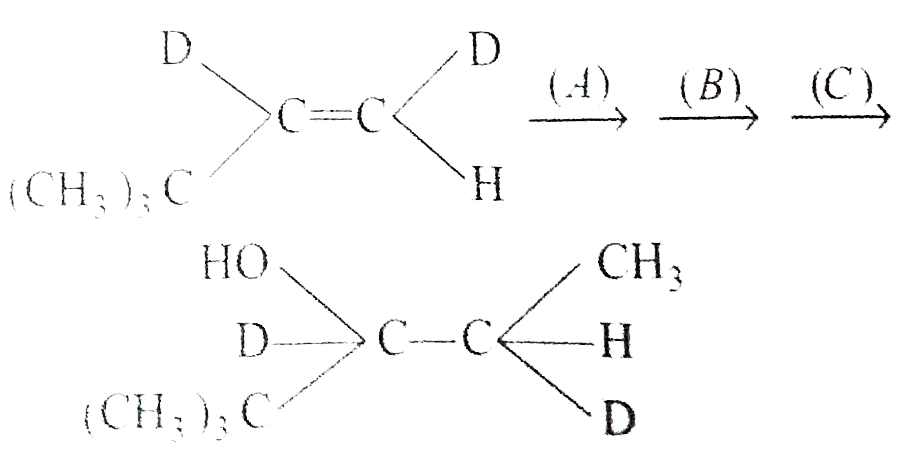During the conversion :
C6H5CH2CH3(a)−−→X(b)−−→C6H5CH=CH2
the reagents (a) and (b) are respectively
SOCl2, alc. KOH
Cl2/hv,H2O
SO2Cl2, aq. KOH
SO2Cl2, alc. KOH
The correct Answer is:D
To solve the question regarding the conversion of C6H5CH2CH3 to C6H5CH=CH2, we need to identify the reagents (a) and (b) used in the process. Let's break down the steps:
Step 1: Identify the starting material and the final product
- The starting material is C6H5CH2CH3, which is a primary alkyl chain with a benzene ring (ethylbenzene).
- The final product is C6H5CH=CH2, which is an alkene (specifically, styrene).
Step 2: Determine the first reagent (a)
- To convert an alkane (or a primary alkyl chain) to an alkyl halide, we can use reagents that will introduce a halogen (like chlorine) to the molecule.
- A suitable reagent for this conversion is SO2Cl2 (thionyl chloride), which can convert the alkane to an alkyl chloride.
Step 3: Determine the second reagent (b)
- After obtaining the alkyl halide (let's say C6H5CH2CH2Cl), we need a reagent that can facilitate the elimination of HCl to form the alkene.
- A common reagent for this elimination reaction is alcoholicKOH, which acts as a strong base to promote the elimination reaction.
Conclusion
Thus, the reagents (a) and (b) are:
- (a) SO2Cl2
- (b) alcoholicKOH
Final Answer
- Reagent (a): SO2Cl2
- Reagent (b): alcoholicKOH
- The starting material is C6H5CH2CH3, which is a primary alkyl chain with a benzene ring (ethylbenzene).
- The final product is C6H5CH=CH2, which is an alkene (specifically, styrene).
- To convert an alkane (or a primary alkyl chain) to an alkyl halide, we can use reagents that will introduce a halogen (like chlorine) to the molecule.
- A suitable reagent for this conversion is SO2Cl2 (thionyl chloride), which can convert the alkane to an alkyl chloride.
- After obtaining the alkyl halide (let's say C6H5CH2CH2Cl), we need a reagent that can facilitate the elimination of HCl to form the alkene.
- A common reagent for this elimination reaction is alcoholicKOH, which acts as a strong base to promote the elimination reaction.
Thus, the reagents (a) and (b) are:
- (a) SO2Cl2
- (b) alcoholicKOH
- Reagent (a): SO2Cl2
- Reagent (b): alcoholicKOH
Topper's Solved these Questions
- HALOALKANES AND HALOARENESBOOK - MODERN PUBLICATIONCHAPTER - HALOALKANES AND HALOARENESEXERCISE - B. MULTIPLE CHOICE QUESTIONS (from competitive Examinations)
63 Videos
- HALOALKANES AND HALOARENESBOOK - MODERN PUBLICATIONCHAPTER - HALOALKANES AND HALOARENESEXERCISE - C. MULTIPLE CHOICE QUESTIONS (with more than one correct answers)
10 Videos
- HALOALKANES AND HALOARENESBOOK - MODERN PUBLICATIONCHAPTER - HALOALKANES AND HALOARENESEXERCISE - HIGHER ORDER THINKING SKILLS
13 Videos
- EQUILIBRIUMBOOK - MODERN PUBLICATIONCHAPTER - EQUILIBRIUMEXERCISE - Unit Practice Test
13 Videos
- HYDROCARBONSBOOK - MODERN PUBLICATIONCHAPTER - HYDROCARBONSEXERCISE - UNIT PRACTICE TEST
15 Videos
Similar Questions
(A) What is the final product in each reaction?
(i)C2H5OHI2−−−−−−→NaOH
(ii)CHCI3Ag−−−−−→Heat?
(iii)CHCI3HNO3−−−→?
(iv)CI4Fe/H2O−−−−→?
(v)C6H5NH2CHCI3−−−−−→KOH?
(vi)C4H9BrNaNO2/C2H5OH−−−−−−−−−−→?

(ix)CH3LiCH2=CH2−−−−−−→?
(x)(CH3)3CCI(CH3)2Zn−−−−−−→?
(xi)H2C=CH3∣C−CH2CH3IBr−−→?
(xii)CH3−CH−CH2NBS−−→?
(xiii)CH3−C∣CH3H−CH2CINaI−−−−−−−−−→Acetone,Δ?
(xiv)R3MgX(CH3)2CO/H2O−−−−−−−−−−→?
(xv)CH3−C∣BrH−C∣CH3H−CH3+HBr→?
(xvi)CH3−C∣CH3H−C∣OHH−CH3+HBr→?

(xx)CH3−CH3∣C∣CH3−C∣CIH−CH3+KOH(alc)→?
(xxi)(CH3)3C−CH2Br+KOH(alc)→?
(xxii)CH3−CH3∣C∣CH3−CH2Br+C2H5OHHeat−−→?

(B)(i)C6H5CH2CH3Br2−−−−−→hv?
(ii)C6H5CH2CH3(i)Br2,heat ,light−−−−−−−−−−−−−−→(ii)NaCN,H2O/H?
(iii)CICH2CH2CH2COPhKOH−−−−−−→MeOH?


View SolutionWrite A,B and C in the given reactions :
(i)C6H5N2CICuCN−−−→AH2O/H+−−−−−→BNH3−−→C
(ii) CH3CH2BrKCN−−→ALiA1H40−−−−→BHNO2−−−→0∘CC
(iii) C6H5NO2Fe/HCI−−−−→AHNO2−−−→273KBH2O/H+−−−−−→2ΔC
(iv) CH3COOH2NH3−−→ΔANaOBr−−−→BNaNO2/HCI−−−−−−−−→C
(v) CH3CH2INaCN−−−→AOH−−−−−−−−−−→partial hydrolysisBNaOH/Br2−−−−−−→C.
View Solution
Knowledge Check
In the given reaction
C6H5−O∣∣C−CH3[X]−−→C6H5−CH2−CH3
[X] will be -ALiAIH4BNaBH4CBu3SnHDNH2−NH2/ΘOHIUPAC name of
C6H5−O∣∣C−CH2CH2−CH2−CH2−CH3A1-phenylhexan-2-oneB6-phenylhexan-2-oneC1-benzylhexan - 2-oneDDodecan-5-oneThe IUPAC name of is
C2H5CH2∣∣C−CH2−CH3∣CHNH2A4-Ethylpent-4-en-2-amineB2-Amino-4-ethylpent-4-eneC2-Ethylpentan-4-amineD4-Amino-2-ethylpent-1-ene
Name the reagent used in the following reactions:
C6H6−CH2−CH3?−−→C6H5−COO−K+
View SolutionComplete the following equations:
a) H2C=CH−CH3+HCl→(A)
b) CH3−CH=C(CH3)2+O3Zn−−→H2O(A)+(B)
c) H2C=CH2+O3H2O−−→(A)NaOH(aq)−−−−−−→(B)+(C)
d) (CH3)3C−CH=CH2+HC<o(A)
d) MeCH2C≡CHNaNH2−−−−→(A)Et.Br−−−→(B)
g) HC≡CHH2,Pd(CaCO3)−−−−−−−−−−→(CH3COO)2Pb(A)Br2−−→Cl4(B)KOH(alc)−−−−−−→(C)
h) HC≡CHHgSO4,H2O−−−−−−−→H2SO4(A)H−−−→LiAlH4(B)concH2SO4−−−−−−→443K(C)
i) CH3CH=(CH2)Br2A773KCl2−−→773K(B)
j) CH3CH=CH2Br2−−→773K(A)KOH(alc)−−−−−−→Δ(B)
k) H2C=CH2+CH2+CH2→(A)
l) CH3CH=CH2+CH2I2→(A)
m) H2C=CH−CH=CH2+H2=CH2→(A)H2−−→Pd(B)
n) C3H7CH=CH2Hg(OAc)2−−−−−−→THF/H2O(A)NaBH4/NaOH−−−−−−−−−→(B)
o) CH3CH=CH2BH3/THF−−−−−−→(A)CH3COOH−−−−−−→(B)
p) C6H5CH=CH2Br2−−→(A)3.0equiv−−−−→CH3I(B)
q) C6H5CH2CH(Cl)C6H5KOH(alc)−−−−−−→Δ(A)
r)

View SolutionWrite the IUPAC name of :
CH2=CH3∣C−CH2−C2H5∣CH−CH3
View SolutionThe IUPAC name of is
C2H5CH2∣∣C−CH2−CH3∣CHNH2
View SolutionWhich of the following is/are the chain termination step during photochloration of ethane?
CH3.CH2+.Cl→CH3−CH2−Cl
CH3.CH2+CH3.CH2→CH3CH2CH2CH3
.Cl+.Cl→Cl2
.Cl+.H→HCl
View Solution
